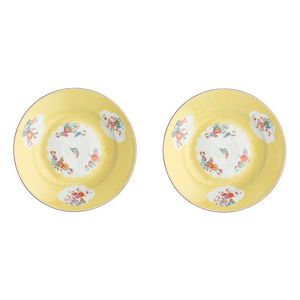Meissen Yellow Hunting Plates, 1730
A pair of Meissen yellow ground plates from the 'Yellow Hunting' service, circa 1730, painted to the centre in a chrysanthemum shaped reserve with a phoenix and flower sprays in the Kakiemon style, the rim with three quatrefoil reserves painted with flowers, brown edge, blue crossed swords mark in underglaze blue and incised black Japanese Palace inventory mark N=148 W to underside, diameter 32.7 cm. Other Notes: ordered by Augustus the strong in 1730 and delivered in late 1734 to the Japanese Palace, it became known as the yellow hunting service due to the similarity of the yellow ground to the hunting livery of the Saxon court huntsmen. It is the only Meissen dinner service with a coloured ground, condition: one restored
You must be a subscriber, and be logged in to view price and dealer details.
Subscribe Now to view actual auction price for this item
When you subscribe, you have the option of setting the currency in which to display prices to $Au, $US, $NZ or Stg.
This item has been sold, and the description, image and price are for reference purposes only.
- Kakiemon Porcelain - Kakiemon porcelain was made from the 16th to the 19th century in the Arita area of Japan, and is generally agreed to include some of the finest porcelain made in Japan. It is decorated with polychrome enamels over glaze, the most popular colours being underglaze blue and enamels of green, blue, turquoise yellow and persimmon red.
The body of a Kakiemon object is pure white porcelain while the enamel overglaze motifs incorporate Japanese and Chinese designs, but leave much of the white surface unpainted. The name derives from the family of potters who are associated with this style of pottery.
Early Kakiemon porcelain was unmarked, and marks on later objects were variable and unreliable.
Kakiemon porcelain was first imported into Europe by the Dutch at the end of the 17th century, and became extremely popular, resulting in Kakiemon-style imitations being produced by European potteries including Bow, Chelsea and Worcester in England, Mennery, Samson and St. Cloud in France, Delft in Holland and Meissen in Germany.
It's rare for an original Kakiemon object to come onto the market, and almost all sold nowadays is of European origin, and described as Kakiemon pattern or Kakiemon style. - Circa - A Latin term meaning 'about', often used in the antique trade to give an approximate date for the piece, usually considered to be five years on either side of the circa year. Thus, circa 1900 means the piece was made about 1900, probably between 1895 and 1905. The expression is sometimes abbreviated to c.1900.
- Incised - A record of a name, date or inscription, or a decoration scratched into a surface, usually of a glass or ceramic item with a blunt instrument to make a coarse indentation. Compare with engraving where the surface is cut with a sharp instrument such as a metal needle or rotating tool to achieve a fine indentation.
- Quatrefoil - A stylised four-circle design, itself contained within a larger circle, with Gothic origins and often seen as window designs in ecclesiastical architecture. The use of the motif was popular in Gothic Revival furniture of the 19th century.
This item has been included into following indexes:
- Meissen (Germany)
